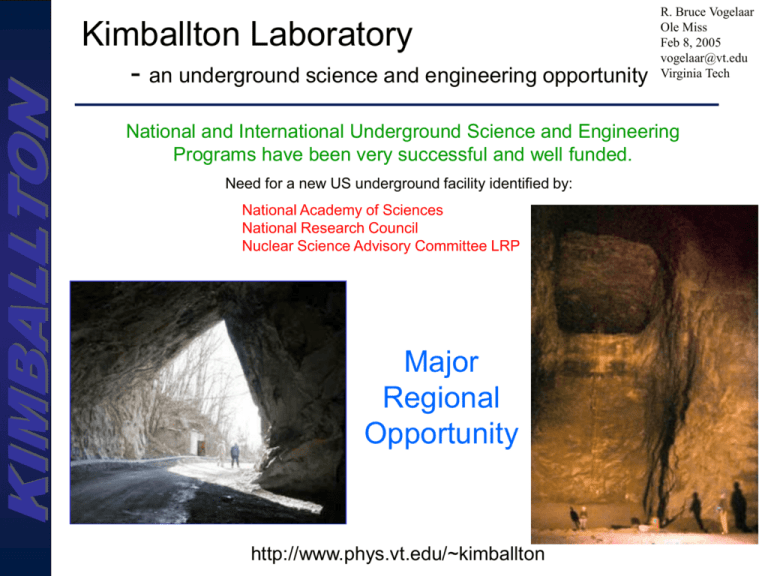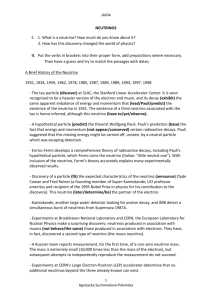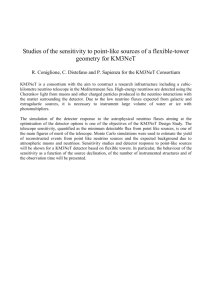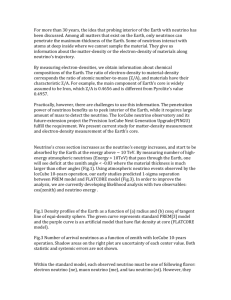Exploring the Stars at Kimballton
advertisement

Kimballton Laboratory - an underground science and engineering opportunity R. Bruce Vogelaar Ole Miss Feb 8, 2005 vogelaar@vt.edu Virginia Tech National and International Underground Science and Engineering Programs have been very successful and well funded. Need for a new US underground facility identified by: National Academy of Sciences National Research Council Nuclear Science Advisory Committee LRP Major Regional Opportunity http://www.phys.vt.edu/~kimballton Deep Underground Science and Engineering Laboratory (DUSEL) Motivation (a la NSF) Geosciences Engineering Geobiology Neutrino Physics Dark Matter Search Nucleon Decay National Security Outreach 5% 25% Oridnary Matter Dark Matter Dark Energy 70% SN1987a from EarthLab Report Some of the ‘Big’ Questions: Evolution of Life – Life Under Extreme Conditions Can We Obtain a ‘Transparent’ Earth? How do Mineral Deposits Form? How do We Make Deep Underground Space? What is ‘Dark Matter’, ‘Dark Energy’? Are Neutrinos Their Own Anti-Particles? Is the Sun Getting Hotter? Are We Being Good Stewards of Water? How do Microbes Affect Geo-chemistry? Can We Optimize the Exploration and Extraction of Earth’s Resources – such as oil? etc… Existing Laboratories Sudbury Neutrino Observatory (Canada) Laboratori Nationale Gran Sasso (Italy) Principle Laboratories Worldwide (by decreasing depth) Homestake (SD) Sudbury (Canada) Mont Blanc (France) Baksan (Ukraine) Gran Sasso (Italy) Kamioke (Japan) Soudan (MN) WIPP (NM) Potential Sites Virginia Polytechnic Institute and State University The Kimballton Mine Active limestone mine Tractor-trailer drive-in access Heart of Appalachian Mountains in Thomas Jefferson National Forest 30 minutes from Virginia Tech owned and operated by Chemical Lime Corporation Kimballton The Valley and Ridge over-thrust structure reflects intense compression along the protoAtlantic Continental margin during the Alleghenian collision event between North America and Africa. The collision created the Pangean super continent some 300 million years ago. The break up of Pangea began in the Triassic Period about 245 million years ago and by the Jurassic Period continental rifts forming the Atlantic and Gulf of Mexico Ocean basins were well established. Valley and Ridge Topography Reveals Some 300 Million Years of Geological History. BUTT MOUNTAIN The modern Appalachian Mountains are forming by gentle uplift, rejuvenation and entrenchment of rivers along the eastern flanks of the Atlantic Basin. Regional Cross Section Allegheny Plateau Valley and Ridge BUTT MTN Butt Mountain is a large synclinal mountain near the western edge of the Valley and Ridge. This region is characterized by linear ridges held up by tilted strata of resistant sandstone with limestone and shale in fault line valleys. Access to outcropping sedimentary strata allows excellent surface structural control based on contrasting stratigraphy.This will also prove to be an asset in designing and exploring laboratory sites in the subsurface. Geology for the Butt Mountain Area, Giles County, Virginia showing section lines DIGITAL GEOLOGIC MAP OF THE RADFORD 30X60 MINUTE QUADRANGLE, VIRGINIA AND WEST VIRGINIA Geology by Mervin J. Bartholomew, Arthur P. Schultz, Sharon E. Lewis, Robert C. McDowell, and William S. Henika 2000 Kimballton Advantages •site in sedimentary rock; •environmentally friendly; •short time to first-science; •heterogeneous known geology; •dormant fault; •repeating geologic layers; •local major research university; •excellent climate, power and transportation; •outreach to Appalachia & mining communities; •support from local community Kimballton Interior Gran Sasso, Hall C Comparative Size of Super-Kamioka in Japan (100 kTon water) dimensions in feet Kimballton (limestone) (Bq/kg) 18±1, 13±1 226Ra 1.2±0.1, 1.9±0.2 226Th 0.6±0.1, 0.9±0.2 Gran Sasso (Dolomite rock) (Bq/kg) 40K 40K Radon concentration 222Rn < 10 Bq/m3 15 226Ra 5 226Th 0.3 Radon concentration 222Rn 40 – 70 Bq/m3 Initial Programs (Facility by April 2005) low-level detector development (Naval Research Laboratory) LENS prototype AMADEUS – NSF ITR funded VT project 100Mo experiment from Duke underground Cu electro-forming development of remote underground handling equipment concepts for first phase laboratory First Detectors - NRL Technology transfer from MPIK & Gran Sasso •Low-Background HPGe (like GeMPI, SEGA, MEGA, etc.) •Gas Proportional Counters (like Gallex, GNO, etc) TYPICAL DUSEL OPTION (7500 ft depth) Capture ALL science needs in lab concept from the start. Rock Strengh > 150MPa Q ~ 23 DUSEL NSF Process Stage I - Science Case (joint proposal submitted Sept 15, 2004) Stage II – Site Designs (due February 28, 2005) Stage III – Engineering & Suite of Initial Experiments Geo/Eng/Bio workshop at Blacksburg, VA Nov 12-14, 2004 Kimballton Team: 139 Current Members (and growing) Duke U Georgia Tech Harvard Iowa State LANL LBL Mich Tech NIST MIT Nav. Res. Lab. NM Tech NCSU ORNL Penn State U Princeton Purdue Temple U Alaska U Arizona U Maryland U Minnisota U Missouri-Rolla U N Carolina U Oklahoma USGS U Tennessee U Toronto U Virginia U Arizona Virginia Tech VC Univ W Virginia U APS Neutrino Study (DNP,DPF,DAP,DPB) 1) We recommend, as a high priority, a phased program of sensitive searches for neutrinoless nuclear double beta decay… 2) We recommend, as a high priority, a comprehensive U.S. program to complete our understanding of neutrino mixing, to determine the character of the neutrino mass spectrum and to search for CP violation among neutrinos… 3) “We recommend development of an experiment to make precise measurements of the low-energy neutrinos from the sun. So far, only the solar neutrinos with relatively high energy, a small fraction of the total, have been studied in detail. A precise measurement of the low-energy neutrino spectrum would test our understanding of how solar neutrinos change flavor, probe the fundamental question of whether the sun shines only through nuclear fusion, and allow us to predict how bright the sun will be tens of thousands of years from now.” Ln (inferred from expt)/L = 1.4 +0.2-0.3(1s)+0.7-0.6(3s) The LENS (low-energy neutrino spectroscopy) detector can do this at the current depth of the Kimballton mine! Discovery Potential of LE solar Neutrinos Physical proof of LMA (compatibility but no smoking gun yet) Improving precision of n parameters 12; 13; m2 Uncover surprises---Sterile Neutrinos Non-Standard Interactions Nu Magnetic moments Validity of CPT Hidden sources of energy (other than nuclear fusion) in sun? Will the sun get hotter in the future? Elastic Scattering or Charged Current? (or both?) Elastic Scattering: Cross section well defined Neutrino energy not defined Spectrum smeared No reaction tag- signal and bgd not uniquely separable Good for Strong Line Source e.g. 7 Be with ultralow bgd BOREXINO (for 7Be) Future CLEAN/HERON for pp Tagged Nu Capture: CC Cross-section must be measured with Source Nu energy uniquely defined Best for spectral information Tag uniquely separates signal & bgd Ideal for resolving spectrum from multiple sources (the case at Low Energies) LENS-Sol only Low Energy Neutrino Spectroscopy ~ 600 Hz / cell due to In Conceptual Design Projected Fractional Uncertainties in Measured Fluxes: 16-32 T In (~400 T total) Item pp 7Be (S/N=10) (S/N=4) 32 T In 16 T In 32 T In 16 T In S=5000/5y S=2500/y S=2500/y S=1250/5y 1.55 2.23 2.12 3.0 Coinc. Detection Efficiency Δε/ε 0.7 0.7 0.7 0.7 No. of Target Nuclei ΔN/N 0.3 0.3 0.3 0.3 Cross Section (Q value) ΔI/I 0.3 0.3 0.3 0.3 Cross Section (B(GT)) ΔM/M 1.8 1.8 1.8 1.8 2.5% 3.0% 2.9% 3.6% Signal/Bgd Statistics ΔS/S Total Uncertainty Δφ/φ Cross section calibration done in Russia with 37Ar source in “LENS-Cal” Hyper Scintillation Detector (~50 kTons) Elementary Particles Proton Decay Neutrino Physics-Long Baseline beams from BNL/Fermilab CP violation in Neutrino Sector 3-nu mixing –θ13 Hierarchy of Neutrino mass matrix Astrophysics of Exploding Stars (Supernovae SN) Geophysical Structure and Evolution of the Earth via geo neutrinos High Red Shift Cosmology Detection and Spectroscopy of relic n bgd from past SN Proponents: John Learned, Sandip Pakvasa (U Hawaii) Robert Svoboda (LSU) Franz Feilitzsch, Lothar Oberauer (TUMunich) Kate Scholberg (Duke U) Bruce Vogelaar, Mark Pitt, Tatsu Takeuchi, Lay Nam Chang, Raju Raghavan (VT) LENA (HSD) Npe ~ 100 / MeV Oberauer, L Proton Decay and LENA (HSD) p Kn • This decay mode is favoured in SUSY theories • The primary decay particle K is invisible in Water Cherenkov detectors • Both it and the K-decay particles are visible in scintillation detectors • Better energy resolution further reduces background Oberauer, L P -> + K n event structure: T (K+) = 105 MeV t (K+) = 12.8 nsec K+ -> m+ n (63.5 %) T (m+) = 152 MeV K+ -> p+ p0 (21.2 %) T (p+) = 108 MeV electromagnetic shower E = 135 MeV m+ -> e+ n n (t = 2.2 ms) p+ -> m+ n (T = 4 MeV) m+ -> e+ n n (t = 2.2 ms) •3 - fold coincidence •the first 2 events are monoenergetic •use time- and position correlation How well can one separate the first two events ? ....results of a first Monte-Carlo calculation (Oberauer – LENA) P decay into K and n K m m K Signal in LENA (HSD) Oberauer, L Background Rejection: • monoenergetic K- and m-signal • position correlation • pulse-shape analysis (after correction for reconstructed position) Oberauer, L • SuperKamiokande has 170 background events in 1489 days (efficiency 33% ) •In HSD, this would scale down to a background of ~ 5 / y and after PSD-analysis this could be suppressed in HSD to ~ 0.25 / y ! (efficiency ~ 70% ) •A 30 kt detector (~ 1034 protons as target) would have a sensitivity of t < a few 1034 years for the K-decay after ~10 years measuring time •The minimal SUSY SU(5) model predicts the K-decay mode to be dominant with a partial lifetime varying from 1029 y to 1035 y ! actual best limit from SK: t > 6.7 x 1032 y (90% cl) Oberauer, L Galactic Supernova neutrino detection with HSD (1) n e + p e + + n Electron Antineutrino (Q = 1.8 MeV) spectroscopy ~7800 (2) n e + 12C e + + 12B (Q = 13.4 MeV) (3) n e + C e + N (Q = 17.3 MeV) 12 - 12 Electron n spectroscopy ~ 65 (4) n x + 12C n x + 12C * with (5) n x + e - n x + e - (elastic scattering off electrons) ~ 480 (6) n x + p n x + p (elastic scattering off protons). 12 C * 12 C + (Q = E = 15.1 MeV) Neutral current interactions; info on all flavours ~ 4000 and ~ 2200 Event rates for a SN type IIa in the galactic center (10 kpc) Oberauer, L SN n detection and neutrino oscillations Modulations in the energy spectrum due to matter effects in the Earth Dighe, Keil, Raffelt (2003) Preconditions for observation of those modulations • SN neutrino spectra ne and nm,t are different • distance L in Earth large enough • very good statistics • very good energy resolution World Class Physics, Geology, Engineering & Biology – near your area – join the team.







